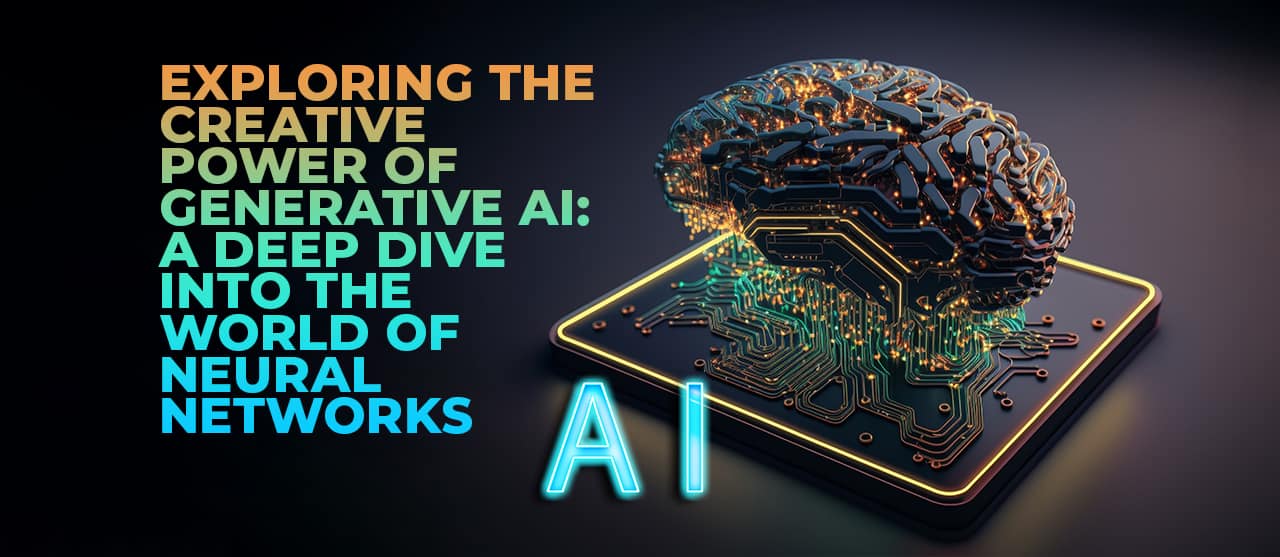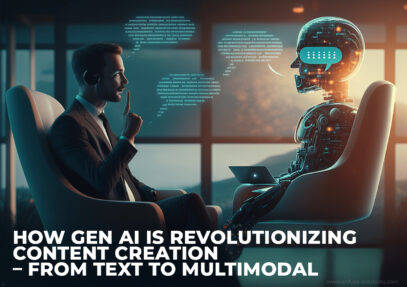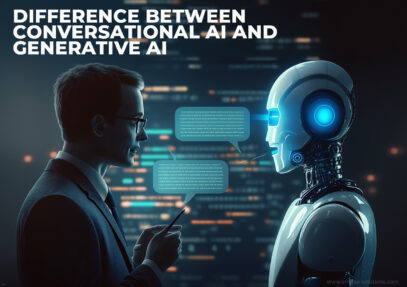
The generative AI field is still in its infancy, but there have been plenty of notable advances to get excited about. From composing music reminiscent of German Composer Bach to crafting stunning visual artworks in the style of renowned artists, generative AI has made remarkable strides in its capacity to generate fresh and innovative content.
This article sheds light on the groundbreaking creative advancements in the field and explores the world of the underlying technology of neural networks.
What Lies Beneath Generative AI?
The technology behind generative AI is rooted in the fascinating world of neural networks. These intricate systems of interconnected nodes mimic the human brain’s neural structure and function. Neural networks leverage algorithms and data to learn patterns, generating new content through training and optimizing performance.
Popular Generative AI models include Generative Adversarial Networks (GANs), Variational Autoencoders (VAEs), and denoising diffusion probabilistic models (DDPMs). GANs generate new data using a generator and discriminator, VAEs process images through an encoder and decoder, and DDPMs create synthetic data by adding and removing noise. Other models also contribute to the diverse landscape of generative AI.
The above-mentioned generative models have sparked innovative use cases and applications, such as Google’s DeepDream utilizing VAEs, and groundbreaking creations like DALL-E, Think Stable Diffusion, Google’s Imagen, and Midjourney. Even Diverse GAN Models are unleashing musical creativity through MidiNet, SSMGAN, and more. These remarkable applications showcase the transformative potential of generative AI in the realms of art, image generation, and beyond.
Exploring The Limitless Applications Of Generative AI In Creative Fields
Generative AI is revolutionizing the creative world, generating endless possibilities to inspire new genres. Its power to traverse creative fields, including image generation, music composition, visual arts, etc., is nothing short of astonishing. Here’s a brief rundown of the same:
1. The Artistic Alchemy: Generative AI In Visual Arts
The emergence of AI image generators can be attributed to the fusion of two distinct technologies: deep learning and generative algorithms. This union has translated into stunning artwork; AI-generated artworks have been recognized by the art world for their technical and artistic quality.
At the Colorado State Fair’s art competition, Jason Allen, president of the tabletop gaming company, claimed first prize in the “digitally manipulated photography” category with his AI-generated artwork titled “Théâtre D’opéra Spatial.” This achievement sparked discussions (and even heated debates) about the evolving role of AI in the world of art.
From what we understand, such capabilities can work well to inspire human specialists across these creative fields (such as design and fashion) to amplify their innovative prowess and productivity. AI can help designers come up with more user-centric and elegant products.
2. Melodic Marvels: Generative AI In Music And Video
Music is an utterly creative medium; generative AI is proving viable here as it works to reinvent the way we compose, produce, and listen to music. This can be attributed to the very nature of music: it can be expressed as numerical sequences, which allows AI algorithms to analyze and learn about different patterns.
Tencent Music Entertainment (TME) claims to have produced and released more than 1,000 AI-generated vocal tracks through the “patented voice synthesis technology”, the Lingyin Engine, with one of the songs amassing over 100 million streams.
3. The Narrative Revolution: Generative AI In Writing And Storytelling
In 2020, Cornell University’s research outlined that OpenAI’s GPT-3 was the largest language model, with 175 billion parameters, generating realistic text on demand. Of course, today, more advanced models (GPT 4 and GPT 3.5) are powering tools and technologies like ChatGPT.
The ability of AI to generate realistic writing, including poetry and prose, is astounding. Machines are ever-expanding their language knowledge, strengthening the bond between creativity and technology. While the writing might not entirely emulate human writing excellence, it does serve other purposes, such as providing inspiration, bolstering research workflows, etc.
4. Blurring The Lines: Generative AI In Film And Animation
Through advanced algorithms and machine learning, AI enhances creativity and streamlines the production process, pushing the boundaries of imagination in the entertainment industry. Tools powered by generative AI, such as film restoration technology, can enhance and upscale old images and movies, elevating their quality to 4K and beyond for a renewed viewing experience.
5. Immersive Experiences: Generative AI In VR And AR
By employing generative AI algorithms, VR and AR applications can deliver immersive and engaging simulations, transforming virtual and augmented experiences. No doubt, VR games that could provide immersive experiences are soaring through the ranks.
What Is Generative AI’s Impact On Industries And Society?
The rise of generative AI technologies has been met with anticipation, concern, and enthusiasm in various industries. While some assume the integration of generative AI to be critical, others are concerned about the possible disruption it could usher in the way we perceive jobs. Regardless, the technology looks promising to be leveraged across industries. Here’s how its influence can be understood:
1. Fostering A Synergy Between Humans And AI
Around 85% of marketers using generative AI believe that it can provide personalized content. Like intrepid explorers, the human-AI synergy could usher a new world of possibilities and navigate uncharted territories of information and discovery.
2. Enhanced Efficiency And Productivity
Generative AI streamlines and automates various business processes, enabling companies to accomplish tasks faster and more efficiently. It can generate reports, analyze data, and provide valuable insights, empowering businesses to make data-driven decisions faster and more accurately.
Future Directions And Potential Developments
AI is going to commoditize and disrupt so many businesses — the way to leverage the technology’s prowess is to be very bold and move forward to embrace AI as quickly as possible. After all, the ability of generative AI to generate innovative and customized solutions, streamline processes, and enhance customer experiences positions it as immensely useful for enterprise initiatives.
At EnFuse Solutions, we are cognizant of these influences and provide solutions with AI to automate data-intensive processes, empowering businesses to make data-driven decisions with greater speed and accuracy. With our industry expertise, we are well-equipped to provide our clients with cutting-edge generative AI solutions that drive growth, efficiency, and competitive advantage. Interested in learning more? Connect with our experts here.

















Comment